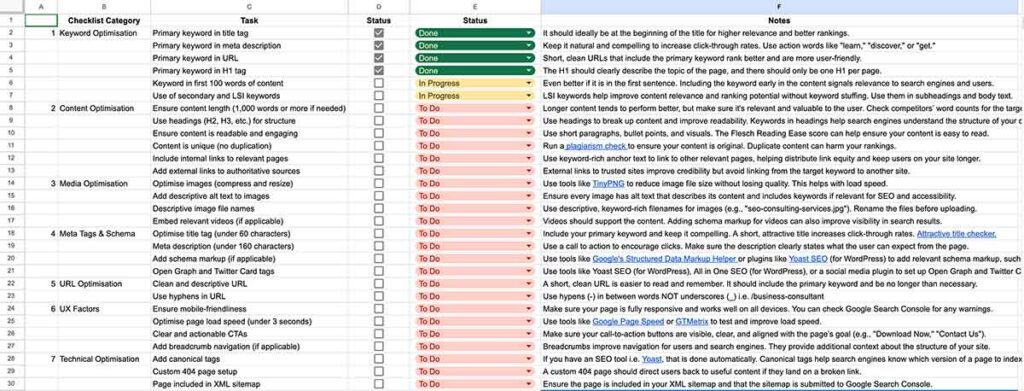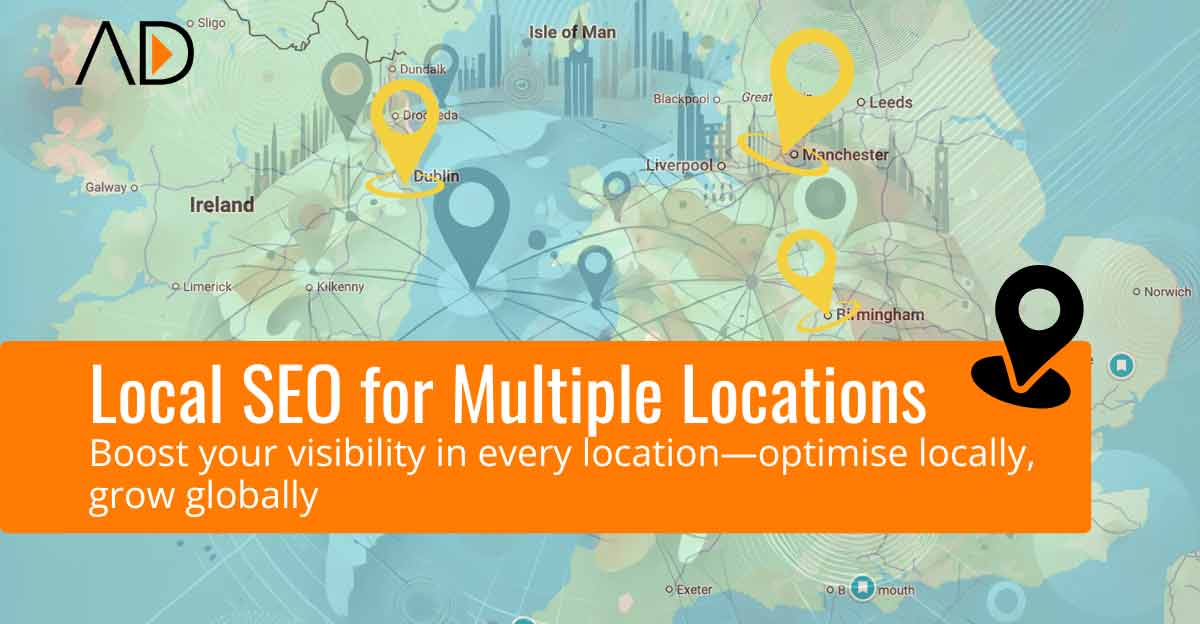Running a small business means wearing many hats—owner, marketer, customer service, and more. With so much to juggle, it’s easy to feel overwhelmed by the idea of optimising your website for search engines. That’s where our SEO tips for small businesses come in. We know for a fact that SEO can bring significant benefits to your business, helping potential customers find you online without relying on expensive ads.
In this guide, we’ve broken down 10 simple and actionable SEO tips that any small business owner can implement to boost their website’s visibility. Whether you’re just starting with SEO or looking to refine your current strategy, these tips will help you attract the right customers and grow your business online.
Let’s get started with the basics!
What is SEO?
Search Engine Optimisation (SEO) is the process of improving your website to increase its visibility when people search for products or services related to your business on search engines like Google. When done well, SEO can bring organic (free) traffic to your website and help your business grow.
Why is SEO Important for Small Businesses?
As a small business, having a well-optimised website means potential customers can find you online more easily. SEO helps you:
- Increase website traffic
- Attract your ideal customers
- Build trust with users by appearing at the top of search results
- Stay competitive, even against bigger brands
Want to take your SEO to the next level? Check out our SEO Services here.
Now, let’s dive into 10 practical SEO tips for your small business!
1. Start with Keyword Research
Keywords are the foundation of SEO. These are the words and phrases people type into search engines when looking for a product or service. Before optimising your site, you need to know which keywords are relevant to your business.
Start by listing what your customers would search for, and use tools like Google Keyword Planner or Ahrefs to find the most popular terms. Remember to choose a mix of broad and specific (long-tail) keywords to target different types of searches.
For a step-by-step guide on how to do keyword research, check out our blog post: How to Do Keyword Research for SEO.

2. Optimise Your On-Page SEO
On-page SEO refers to the content and HTML source code of a page that you can optimise to improve your ranking. Important factors include:
- Title Tags: Use your primary keyword here.
- Meta Descriptions: Write a concise description including keywords.
- Headings: Include keywords in H1, H2, and H3 tags.
Ready to optimise your pages? Download our On-Page SEO Checklist to guide you through the process.

3. Create Quality Content
Content is king in SEO. By creating valuable content that answers your audience’s questions, you can attract visitors and keep them engaged. Focus on creating blog posts, guides, and videos that are informative, relevant, and engaging.
However, here’s a common mistake small businesses make: they often create content that isn’t directly related to their core business or services. This can confuse both Google and your potential customers. To avoid this, make sure your content is always relevant to what you offer.
Additionally, many small businesses focus heavily on blog posts but overlook creating specific content for each of their services. Rather than grouping all your services onto a single page, create individual service pages with detailed, keyword-optimised content for each one. This will help Google understand what you offer and make it easier for potential clients to find the exact service they need.
Don’t forget to naturally include your keywords in your content to ensure it ranks well in search results!
Learn more about our Content Marketing Services to keep your content fresh, targeted, and SEO-friendly.
4. Use Internal and External Links
Internal Links
Internal linking involves adding links to other pages on your website. This helps search engines understand your site’s structure and ensures visitors spend more time on your site. Internal links also pass authority from one page to another, boosting your SEO.
How to use internal links
- When writing a blog post, include links to related pages or services on your website. For example, in this blog post, I’m discussing SEO tips for small businesses, and I can mention our SEO Audit Services, which is particularly helpful for businesses that want an expert review of their SEO strategy.
- This way, I:
- Provide value by informing readers about a service that could help them.
- Build an internal link to the SEO Audit page, which improves its SEO.
- This way, I:
Similarly, if I’m writing about content creation, I could mention our Content Marketing Services. Internal linking keeps your audience engaged and helps search engines rank your important pages.
External Links
External links are links from your pages to other websites. These can help support your content and provide additional useful information to your readers. However, be mindful of what you link to, especially if you’re trying to rank for a specific topic.
How to use external links (the right way)
- When linking to external sites, avoid linking to content that directly competes with your services. For example, since I want to rank for SEO-related keywords, I wouldn’t want to link to another SEO guide that could pull visitors away from my site.
Instead, find external content that complements your services. For instance, while Aksel Digital offers SEO and digital marketing services, we don’t provide Public Relations (PR) services. So, I could link to a helpful guide on PR Tips for Small Businesses. This way, I:
- Offer useful information without driving my target audience away from my site.
- Provide value through complementary content.
Why this works
- External links to non-competing, complementary content help build trust and authority while keeping your audience engaged.
- They demonstrate that your content is well-researched without driving potential clients away from your core offerings.
By using internal and external links wisely, you can provide your audience with a rich resource of information while keeping them engaged on your website. For more help with on-page SEO strategies, check out our SEO Services.
5. Claim and Optimise Your Google Business Profile
For local SEO, it’s crucial to claim and optimise your Google Business Profile. Ensuring that your profile is complete with accurate business details, opening hours, and customer reviews can significantly boost your presence in local searches.
But there’s another critical factor—choosing the right business category. This helps Google better understand your business and show it to the right audience. For more details on this, check out our Google Business Categories post.
Here is what further steps you can take to improve your site’s visibility
Use Business Listings
In addition to Google Business, it’s a good idea to list your business in other directories like Yelp, Bing Places, and industry-specific listings. This makes it easier for search engines to find your website, improving your local SEO and making your business more visible in your area.
You can check our free business listings blog post to find some of the business listings you can use for free.
Publish Guest Posts and Get Featured in Industry Blogs
But don’t stop there! You should also publish content on other websites and blogs related to your industry. Guest posts and features in industry blogs act as online referrals, driving traffic back to your website and boosting your SEO. This practice not only improves your visibility but also strengthens your website’s authority in the eyes of search engines.
Keep in mind that not all backlinks are created equal. Links from high-quality, relevant industry blogs carry more weight than random links from unrelated sites.
Use Professional SEO Services
You can always use our Local SEO Services can help you manage your Google Business Profile, business listings, and other local SEO strategies to ensure your business stands out and attracts local customers while you manage services.
6. Optimise for Mobile Users
More people browse the web on their mobile devices than ever before. Ensure your site is mobile-friendly by using a responsive design that adjusts to different screen sizes. Google also prioritises mobile-friendly websites, making this a key ranking factor.
Looking for a site that’s fully optimised? Explore our Web Design Services and Website Audit Services to create a seamless mobile experience for your users.
7. Improve Page Loading Speed
No one likes waiting for a slow website to load, and search engines take page speed into account when ranking websites. An easy win for small businesses is to optimise images. You can use free tools like TinyPNG or ImageOptim to compress images without sacrificing quality.
If you’re unsure about your site’s speed, tools like Google PageSpeed Insights can give you valuable insights and recommendations.
8. Use Local Keywords
If your small business serves a specific geographic area, include local keywords in your content. For example, if you’re a bakery in London, you should include keywords like “best bakery in London” in your content and metadata.
Want to improve your local visibility? Contact us about Local SEO Services.
9. Monitor Your SEO Performance
SEO is not a one-time task; it requires regular monitoring to ensure that your strategies are working. To track your website’s progress, use free tools like Google Analytics and Google Search Console. These tools provide insights into:
- Traffic sources: Understand where your visitors are coming from.
- Keyword performance: See which search terms are driving the most traffic.
- Bounce rate: Check how many visitors leave your site after viewing just one page.
- Page performance: Identify which pages perform well and which need improvement.
By consistently monitoring your SEO performance, you can make data-driven adjustments to your strategy, ensuring long-term success.
10. Have a Clear Site Structure
A well-structured website is not only easier for your visitors to navigate, but it also helps search engines crawl and index your site more effectively. Use categories and subcategories to organise your products or services, and make sure your URLs are clean and descriptive.
For example:
- Instead of: yourwebsite.com/page?id=123
- Use: yourwebsite.com/services/seo-consulting
- Instead of: yourwebsite.com/category1/product1
- Use: yourwebsite.com/shop/organic-flour
Need help structuring your website for SEO? Check out our SEO Services or learn more about what makes us the leading SEO agency in London on our homepage.
Free Download
Download Free Keyword Map Template
To make this process easier, download our free Keyword Map Template to start organising your keywords effectively. This template will help you map out your keywords, assign them to the right pages, and track your progress as you optimise your site.
Free Download
Boost Your SEO with Our Free On-Page SEO Checklist!
Want to improve your website’s rankings and visibility? Download our free On-Page SEO Checklist to ensure your content is fully optimised for search engines and users alike. This step-by-step guide will walk you through all the essentials, from keyword placement to technical optimisation.




